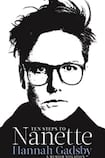
Hannah Gadsby’s 2018 Netflix stand-up show, Nanette, ias a phenomenon. In a masterwork fuelled by a purposeful rage, Gadsby controls the audience’s tension like an orchestral conductor, railing against misogyny, homophobia and internalised shame, using her personal traumas to critique the medium of comedy itself. By the end, she announces she will quit comedy forever. It received huge acclaim, landing as it did right at the moment of global catharsis that was the #MeToo movement.
Nanette was an overnight sensation decades in the making. In Ten Steps to Nanette: A Memoir Situation, Gadsby sets out the circumstances in her life that shaped the creation of Nanette. The title might suggest a tight, tidy structure but this is a big, busy book, replete with footnotes, which begins with the epilogue, the red carpet of Hollywood where Gadsby is collecting her Emmy award and being gushed at by Jennifer Aniston (who is forced to admit she hasn’t seen the show).
Pages are devoted to stories of dogs and bikes and broken arms, whereas hugely impactful events that shape her psyche and her work are dealt with in a sentence
Then we go back. Born in 1978, Gadsby grew up in small-town Tasmania, one of five kids. Her hilarious mother owned every room she walked into while her father, who was a maths teacher, conveyed calm. She had a happy family life – her relationship with her mother is touchingly portrayed – but she always felt a disconnect from the world around her. It would not be until her 30s that Gadsby received an explanation by way of an autism diagnosis, which she embraced: “I believe communities need thinkers like me.”
In her memoir, vivid childhood anecdotes are set against the background of the struggle for gay rights in Tasmania in the ’80s. Homosexuality was illegal until 1997, and the long debate around its legalisation was vicious. Struggling with her own sexuality for years, Gadsby would come to realise she had internalised the homophobia of her homeland.
When Gadsby reveals she was molested repeatedly from the age of 11 by “an upstanding citizen” and then raped in her early 20s, these devastating times are dealt with with remarkable brevity. She does not want to “prioritise my abuse in the telling of my story, because it was not a luxury I could afford at the time that it was happening”.
This can leave a strange sense that the focus is in the wrong places. Pages are devoted to stories of dogs and bikes and broken arms, whereas hugely impactful events that shape her psyche and her work are dealt with in a sentence. Their shadows loom large. But Gadsby is adamant that her story not read like some “rags to riches inspiration porn” and wants the world to “stop demanding gratuitous details in exchange for empathy”. She rejects neat narratives: “there is never a straight line to be found through a life punctuated by trauma”.
Gadsby is a ground-breaking new type of artist, one who offers trigger warnings to her readers, and is at pains to note her own white privilege
For much of her young adult life, Gadsby floundered, homeless at times, working as a fruit picker. She had several severe depressive episodes in these years and suffered a vicious homophobic attack. These would haunt her and become a driving force in the narrative of Nanette.
The at-times stilted prose in early on gives way to a new ease of language when Gadsby enters a comedy competition and finds focus in the world of stand-up. For many years she sanded down the sharp edges of her pain and made it part of her set – the agony of coming out to her parents, the body shaming. She tried to control how the world saw her through her act. Fat jokes were her bread and butter, “but that type of bread and butter is a shame sandwich”.
After a decade working as a long-form comic, Gadsby wanted to pull the tradition asunder and rebuild it – first by removing self-deprecation from her set. “If you already exist in the margins, self-deprecation is not humility, it’s humiliation.” To preserve herself, she could no longer play her trauma for laughs.
The writing of the Nanette show is recounted in exhaustive detail, flying in the face of the old idea that if you’re explaining a joke, you’re losing. Some parts, microdosing MDMA to avoid panic while exploring her trauma, are more interesting than others. However, as Gadsby’s grandmother would say, “It’s all part of the soup.”
Ten Steps is a serious book about comedy, and Gadsby is a ground-breaking new type of artist, one who offers trigger warnings to her readers, and is at pains to note her own white privilege. In Nanette, she was concerned with creating a place of “healing catharsis” for the audience – not a typical concern for a stand-up comedian (cough, Jimmy Carr). However, while there is real merit in this deep exploration of a complex work and its creator, it’s unlikely the memoir will have the same mass appeal as Nanette itself.










